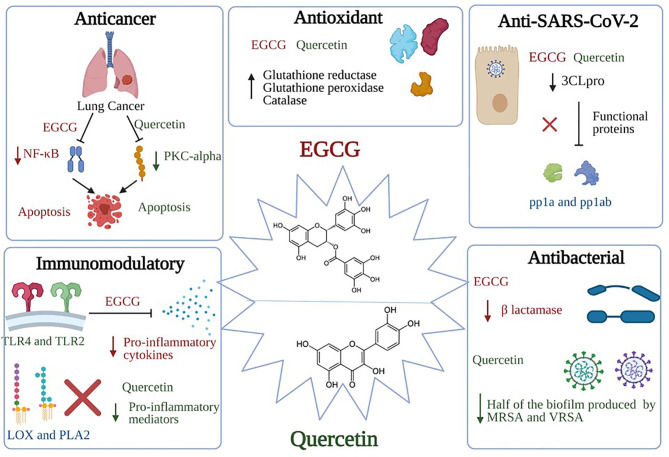Figure 3.
Significant pharmacological activities of EGCG and quercetin. Green tea, with its main two active constituents EGCG and quercetin, contributes to a wide range of medicinal activities such as antioxidant, immunomodulatory, anticancer, antiviral, and antibacterial actions. EGCG anticancer activity is produced by suppressing the NF-κB signaling in A549 and H1299 cells; activation of apoptotic cascades are also initiated, resulting in a marked hindering of cellular proliferation. On the other hand, quercetin inhibits the protein kinase C (PKC-α), a survival signaling protein, repressing several cancer hallmarks. Concerning the immunomodulatory actions, EGCG induces TLR4 and TLR2 expression levels, thus depleting the mitogen-activated protein kinase (MAPK) pathway and repression of pro-inflammatory cytokines release. As for the quercetin, it inhibits pro-inflammatory mediators such as Lipoxygenase and Phospholipase A2. Besides, both constituents share the same antiviral mechanism against SARS-CoV-2, which is binding to “3Clpro” or “Mpro”, preventing the processing of viral proteins pp1a and pp1ab into functional proteins in the host cells. Bona fida, the antioxidant effects of both EGCG and quercetin are mediated through scavenging and neutralizing the free radicals and boosting the enzymes that are responsible for detoxification such as glutathione reductase, glutathione peroxidase, and catalase. Finally, quercetin showed potential antibacterial activity through inhibiting half of the biofilm production by methicillin-resistant S. aureus (MRSA) and vancomycin-resistant S. aureus (VRSA). Similarly, EGCG showed antibacterial activities through inhibiting the B lactamase production and neutralizing the released toxins.

